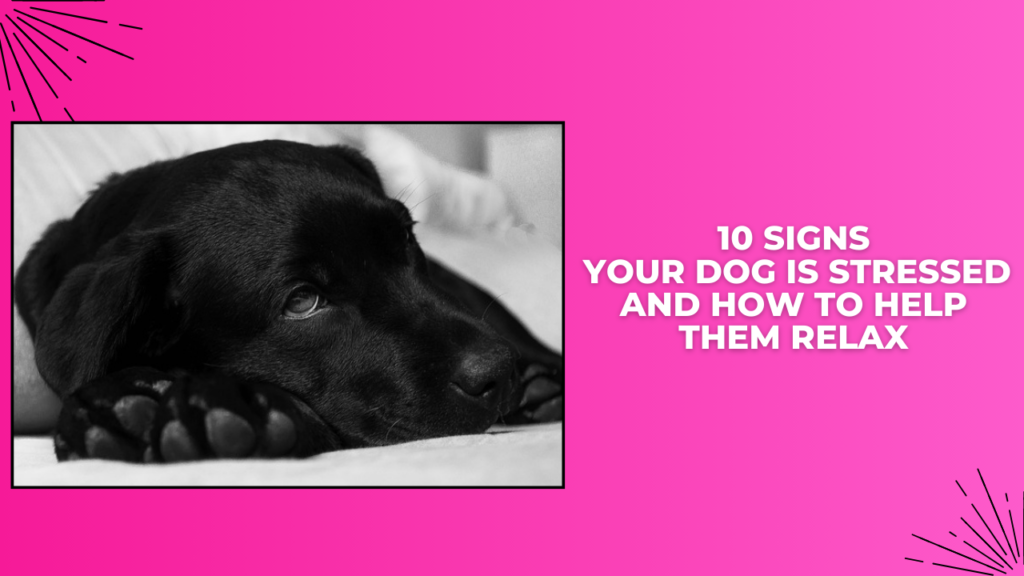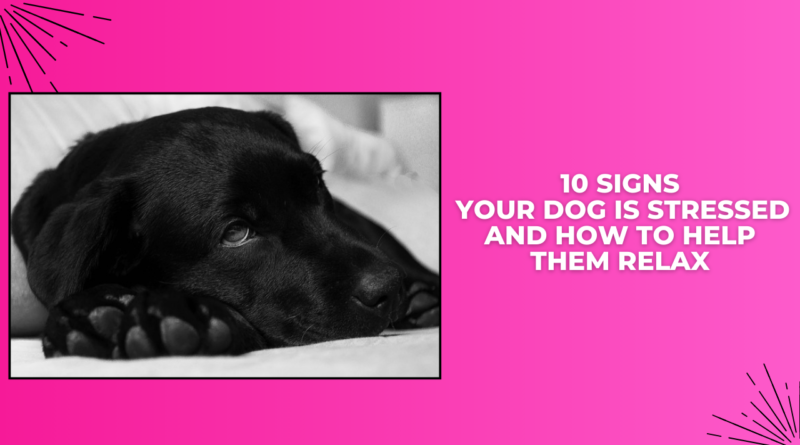10 Clear Signs Your Dog Is Stressed and How to Help Them Relax
As dog owners, we all want our furry friends to lead happy, stress-free lives. However, dogs, like humans, can experience stress. Recognizing the signs your dog is stressed and knowing how to alleviate their anxiety is essential for their health and well-being. In this comprehensive guide, we’ll explore ten critical signs of stress in dogs, the underlying causes, and actionable steps to help them relax.

Why Understanding Stress in Dogs Matters?
Stress in dogs can lead to both physical and behavioral issues if left unaddressed. Chronic stress weakens their immune system, makes them more susceptible to illness, and can disrupt their daily routines. By identifying the signs your dog is stressed early, you can ensure your pet stays happy and healthy.
The Science Behind Dog Stress
Dogs experience stress through the activation of their hypothalamic-pituitary-adrenal (HPA) axis. This leads to the release of cortisol, a stress hormone. While short-term stress can be beneficial, chronic stress can negatively impact their immune system, digestion, and overall health. By managing their stress levels, you’re also supporting their long-term well-being.
10 Signs Your Dog Is Stressed
1. Excessive Panting or Drooling
Panting is normal for dogs, especially after exercise or on hot days. However, excessive panting or drooling when they haven’t been physically active can be a critical sign of stress in a dog. Stress-induced panting is often shallow and rapid, accompanied by an anxious demeanor.
What to Do:
- Remove your dog from the stressful environment.
- Offer water and a calm, quiet space to relax.
Related Tip: Monitor your dog’s panting patterns during different situations to distinguish between normal and stress-related behavior.
2. Changes in Body Language
Dogs communicate a lot through their body language. Signs of stress in dogs include:
- Tucked tail
- Pinned-back ears
- Raised hackles
- Lip licking or yawning excessively
What to Do:
- Observe your dog closely to identify what’s causing the stress.
- Use a soothing voice and avoid sudden movements to help them feel safe.
Related Insight: Changes in body language are one of the clearest signs your dog is stressed and may indicate rising anxiety. If your dog yawns frequently in non-sleep-related contexts, take note of their surroundings.
3. Avoidance Behaviors
A stressed dog may avoid people, other dogs, or situations they previously enjoyed. They might hide under furniture, turn away, or refuse to make eye contact.
What to Do:
- Give your dog space and time to feel comfortable.
- Gradually reintroduce them to the environment or situation causing stress, using positive reinforcement.
Training Tip: Use desensitization techniques to help your dog overcome fear and avoidance behaviors over time.
4. Increased Vocalization
Whining, barking, or howling more than usual can indicate stress or anxiety. These vocalizations are often your dog’s way of seeking comfort or expressing discomfort.
What to Do:
- Speak to them in a calm tone.
- Distract them with toys or engaging activities.
Quick Note: Keep a diary of your dog’s vocalization patterns to better understand triggers and patterns.
5. Destructive Behaviors
Chewing furniture, digging excessively, or shredding household items are common signs of stress. These behaviors often occur when your dog is left alone or feels overwhelmed.
What to Do:
- Provide stress-relief toys, like puzzle feeders or chew toys.
- Ensure your dog gets plenty of exercise and mental stimulation.
Did You Know? Chewing helps dogs release tension. Providing safe chew toys can help alleviate stress effectively.
Dog Health Tips: 10 Proven Tips for Keeping Your Dog Healthy and Happy
6. Changes in Appetite
Stress can affect your dog’s appetite. They may stop eating or, conversely, overeat. A sudden change in eating habits is often one of the clearest dog anxiety symptoms.
What to Do:
- Stick to a consistent feeding schedule.
- Offer their favorite treats to encourage eating.
Nutritional Note: Avoid introducing new foods during periods of stress, as it may add to their discomfort.
7. Frequent Shaking or Trembling
While shaking off water is normal, frequent trembling or shaking in non-wet conditions is a sign of stress. This behavior often follows a frightening event or encounter.
What to Do:
- Gently pet your dog to reassure them.
- Create a calm environment, free of loud noises or disruptions.
Extra Tip: Pair calming music with a quiet space to help soothe a trembling dog.
8. Pacing or Restlessness
A stressed dog may pace back and forth or appear unable to settle down. This is especially common in unfamiliar or high-stimulation environments.
What to Do:
- Take them to a quieter area.
- Engage them in a relaxing activity, such as a slow walk.
Behavior Tip: Ensure your dog’s environment includes familiar items like their bed or toys to provide comfort.
9. Changes in Sleeping Patterns
Stress can disrupt your dog’s sleep. They may sleep more than usual as a way to escape stress or struggle to settle down and rest.
What to Do:
- Ensure they have a comfortable and quiet sleeping area.
- Stick to a regular bedtime routine to promote relaxation.
Rest Insight: A lack of restful sleep can exacerbate stress. Consider tracking your dog’s sleep patterns to identify irregularities.
10. Excessive Grooming or Scratching
A stressed dog may lick, chew, or scratch themselves excessively. This can lead to skin irritation or even injury if not addressed.
What to Do:
- Check for underlying medical issues, such as allergies or parasites.
- Redirect their behavior with interactive toys or playtime.
Skin Health Tip: Introduce soothing shampoos or grooming sprays designed to reduce skin irritation caused by stress-related licking or scratching.
Common Causes of Stress in Dogs
Understanding what’s causing your dog’s stress is key to helping them relax. Here are some common triggers:
- Separation Anxiety: Being left alone for extended periods.
- Loud Noises: Thunderstorms, fireworks, or household appliances.
- Changes in Environment: Moving to a new home or introducing new pets.
- Lack of Socialization: Fear of unfamiliar people, animals, or situations.
- Health Issues: Pain or discomfort from an underlying condition.
Pro Tip: Gradually expose your dog to potential stressors in a controlled, positive manner to build resilience.
How to Calm a Stressed Dog
Now that you know the signs your dog is stressed, here are effective strategies to calm your furry friend:
1. Create a Safe Space
Provide a quiet and cozy area where your dog can retreat when they feel stressed. Use their favorite blanket or toys to make the space comforting.
2. Stick to a Routine
Dogs thrive on routine. Consistent feeding, walking, and playtimes can reduce their anxiety by creating a sense of stability.
3. Exercise and Mental Stimulation
Physical activity and interactive toys can help release pent-up energy and reduce stress. Regular walks, playtime, and training sessions are essential.
4. Calming Products
Consider using calming aids like:
- Dog pheromone diffusers or sprays
- Anxiety wraps, such as ThunderShirts
- Calming treats or supplements (consult your vet first)
5. Practice Positive Reinforcement
Reward your dog with treats and praise when they exhibit calm behavior. This reinforces their sense of security and trust.
6. Professional Training or Behaviorists
If your dog’s stress persists, consider working with a professional trainer or animal behaviorist. They can develop a customized plan to address anxiety.
When to Seek Veterinary Help
While many stress-related behaviors can be managed at home, some cases require professional intervention. Contact your veterinarian if:
- Stress symptoms persist or worsen
- Your dog’s appetite changes drastically
- They exhibit aggression or other severe behavioral changes
Your vet can rule out medical conditions and recommend additional treatments, such as medication or specialized therapies.
Final Thoughts
Recognizing the signs your dog is stressed and addressing them promptly is crucial for their overall well-being. By understanding the critical signs of stress in a dog and learning how to calm a stressed dog, you can create a safe and supportive environment for your furry companion. Remember, a calm and happy dog is a healthy dog.
Take the time to observe your pet, provide them with the care they need, and consult professionals when necessary. With patience and love, you can help your dog live a stress-free and joyful life.
Bonus Section: Long-Term Stress Management Tips
- Regular Vet Checkups: Routine health checks can help catch potential issues early.
- Socialization Activities: Introduce your dog to new environments, people, and pets in controlled settings.
- Quality Time: Spend dedicated one-on-one time with your dog daily to strengthen your bond.
- Mindful Feeding Practices: Use feeding time as an opportunity to reinforce positive behaviors and calmness.
Building a strong, trusting relationship with your dog is the best way to reduce stress and promote a lifetime of happiness.
Additional Strategies to Consider
Enriching Their Environment
- Rotate toys weekly to keep your dog engaged.
- Provide access to outdoor spaces for fresh air and exploration.
Massage Therapy
- Gently massage your dog to relax their muscles and lower cortisol levels.
- Focus on areas like the neck, back, and legs to relieve tension.
Aromatherapy
- Use dog-safe essential oils, such as lavender, to create a calming atmosphere.
- Consult your vet before using any new products.
Create a Daily Relaxation Routine
Establish a routine that includes:
- Morning walks for physical exercise.
- Afternoon play sessions to release energy.
- Evening quiet time with gentle petting or cuddling.
By implementing these strategies and paying close attention to your dog’s needs, you can ensure they live a happy, stress-free life. Continue learning about your dog’s unique personality and behaviors to better support their emotional and physical health.

